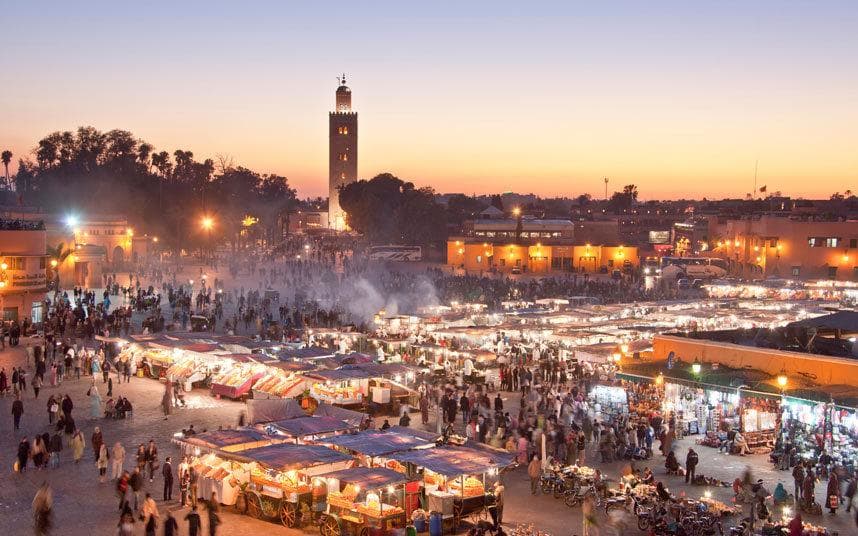The exuberant magic of Marrakech,city of a thousand colors

A trip to Marrakech is always a success. At first glance Marrakech manages to blend in with the desert sands thanks to the reddish ocher of its buildings and walls. Although it is known as the Red City, the truth is that Marrakech is the city of a thousand colors.
Unlike Chefchaouen which is located in the northwestern part of the country of Morocco. It is known for the spectacular blue buildings of different shades of its old town, as well as for its cobbled and sloping alleyways, full of looms and leather goods.
However, the nuances soon arise, as the city rises before a great palm oasis, a green spot in the middle of the aridity, and is framed between the high peaks of the Atlas, which peaks its snowy peaks through the streets of the city.
Marrakech was founded in 1062 as an Almoravid settlement and transformed into an imperial city of the Almohads who made it its capital, embellishing it in 1157 with the Kutubia mosque, one of the most beautiful monuments of the Maghreb.
Before visiting this artistic jewel, it is convenient to discover the soul of the city: the Djemaa el Fna square. «Better than Arzak and the Roca brothers, come, come and try …»
A square with its own life
Heart throbbing in the city, this square stopped in time has two faces. From sunrise to sunset it is the scenario that all kinds of artists and lifeguards share.
The first to take place are the women who tattoo with henna or henna, which are followed by snake charmers, salt-bankers, swallowers, water heaters, corkscrews, chiropractors.
In the late afternoon, smoke from the stove and the smell of spices announce the arrival of food stalls at Djemaa el Fna, where whole families and tourists share a table and conversation.
Towards the Old Core
Strolling aimlessly through the medina you will arrive safely at the Kutubia mosque, oriented by its slender minaret that would inspire that of the Giralda in Seville and is visible from many places, thanks to an old ordinance still in force, which prohibits others Old town buildings exceed palm trees in height.
The Kutubia is the brightest heritage of the Almohad period and a beautiful corner, since the surrounding gardens, with orange trees and ponds, are ideal for taking a break from the hustle and bustle of Djemaa el Fna and the transfer of the souks.
Before leaving the old center of Marrakech it will also be worth visiting the Dar Si Saïd Museum, with luxuriously decorated rooms where handicrafts from southern Morocco are exhibited, and especially the Madrasa of Ben Youssef.
We travel this frantic city from the Djemaa El Fna square to the most important monuments and souks of one of the most visited cities in Morocco.
Djemaa El Fna Square
From the terraces of the cafes that surround it you get a wide view of the throbbing center of Marrakech. From the sunrise to the door of the sun is the scenario that all kinds of artists, hustlers, tourists and locals share.
La Menara
Outside the Medina is the imperial garden, a park erected in the twelfth century for the enjoyment of the sultans, converted today into a peaceful garden. Walled, with olive trees and fruit trees, it has a pavilion of the s. XIX. In the background, the tops of the Atlas.
Sahara Desert
To the southeast of Marrakech lies the immense Sahara, with its orange dunes, dotted by oases and some fortified enclosure (ksar). Touring the desert is an unforgettable experience that allows you to know the way of life of the Bedouins.
Zocos neighborhood
This labyrinth of merchandise, organized by guilds (wrought iron, wickerwork, furs, leather goods, textiles), is accessed from Djemaa Square by Samarine Street. The most advisable thing is to get carried away by the inertia of its streets, talk with the vendors and taste and smell the delights of its stores.
Madrasa Ben Youssef
The visit to this Koranic school, one of the largest in the Maghreb, shows the delicacy of Islamic art, founded in the fourteenth century, which has been restored and today sports its marble floors, zellij tiles, plaster stucco and magnificent works in wood.
Ouarzazate
With its magnificent natural scenery and cinema, it is the starting point of the best routes through the Great Atlas, the last stop before the dunes and the fertile oases that dot the Sahara for those who want to enter the desert.







